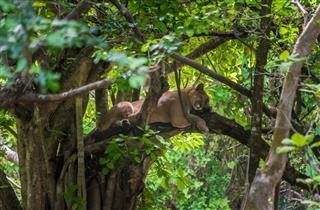
With temperatures fluctuating between 120 °F during the day and 40 °F at night, survival in the scorching desert of Arizona is definitely a Herculean task, and yet, some animals pull it off with immense ease.
The Sonoran Desert spans Arizona and California in the United States and Sonora and Baja California in Mexico. Covering an area of 120,000 square miles, it is the largest and hottest deserts in North America. Even though the temperature reaches 120 °F in this region at times, there is no dearth of life here. In fact, you get to see some of the most amazing animal adaptations in this desert.
Mexican Gray Wolf
The Mexican gray wolf (Canis lupus baileyi), the smallest subspecies of the Gray wolf, is native to the Sonoran and Chihuahuan deserts in North America. Approximately 1.5 meters long and 31 inches tall, this animal weighs about 60 to 80 lbs. It mainly feeds on small animals like squirrels and mice. Sometimes large animals, like deer, are attacked for food, but mainly the young ones. During food scarcity, it sustains on carrion. Once found in abundance, the Mexican gray wolf went through a phase of excessive eradication from the beginning of the 20th century, as it became a nuisance for farmers who wanted to protect their domestic livestock from this animal. In 1976, it was declared ‘endangered’. By the end of the 20th century, the United States Fish and Wildlife Service (USFWS) began reintroducing it in Arizona. A survey by officials in 2006 – 07 estimated that around 60 wolves inhabited this area.
Mountain Lion
The mountain lion (Puma concolor), also known as puma or cougar, is a member of the Felidae family found in America. It measures 2.4 meters in length and 2 feet in height and weighs around 120 to 160 lbs. The cougar hunts a wide variety of prey ranging from rodents and rabbits to cattle and deer. This solitary animal can travel miles in search of food. It has adapted itself to the environment of the Sonoran desert. Being nocturnal, it only hunts at night. During the day time, it takes shelter in caves and crevices in the mountains. The stalk-and-ambush hunting method it resorts to, is an apt method for hunting in this region. As far as conservation is concerned, it is the least vulnerable species according to the International Union for the Conservation of Nature (IUCN).
Great Horned Owl
The Great Horned Owl (Bubo virginianus) is a species of owl found in North America. It is approximately 18 to 27 inches tall and has a wingspan of 40 to 60 inches. The females are larger than the males. It can weigh up to 3 lbs and has a life expectancy of about 5 to 15 years. The bird has an astounding digestive system, which allows it to swallow the whole prey and disgorge the bones or other unwanted parts in form of pellets. The nocturnal bird has a powerful eyesight. It swoops on the prey and lifts it up with its powerful claws. It is capable of lifting animals which are heavier than themselves. The Great Horned Owl is carnivorous in nature, and feeds on rabbits, raccoons, squirrels and even other owls. Found in abundance, this bird is enlisted as least vulnerable species by IUCN.
American Golden Eagle
The American Gold Eagle (Aquila chrysaetos canadensis) found in the Arizona Desert belongs to the Accipitridae family of birds. It can grow to a length of 3 ft, weigh around 9 to 12 lbs, and has a wingspan of 7 ft. The large pair of wings helps it soar in the vast skies of the arid region. The bird builds its nest in the crevices of high cliffs, so that it can keep a watch on its young ones while it is maneuvering in the sky. It defends its territory from intruders by swooping on them and forcing them to flee. As with several other species, even this bird uses the rising mass of warm air in the desert to soar in the sky. When it notices a prey on the ground, it just tucks its wings in and swoops on it at a tremendous speed. The American Gold Eagle feeds on prairie dogs, cottontail rabbits, reptiles and even small birds flying in the sky. At times, it has been seen feeding on carrion as well.
Western Diamondback Rattlesnake
The western diamondback rattlesnake (Crotalus atrox) is a venomous species of the diamondback rattlesnake native to the United States and Mexico. It is also known as the Arizona diamond rattlesnake or desert diamondback. The western diamondback is responsible for a majority of snakebite deaths in Mexico every year. On an average, it can grow up to 4 ft in length; though specimen measuring up to 5 ft have also been reported. It is generally grayish brown in color and has around 20 to 25 irregular spots on its dusty body. It is an ambush predator, which hunts at dawn or during the night. It hides in the sand and waits for the prey. When the prey is within reach, it pounces on it and injects its deadly venom to kill it. The western diamondback feeds on prairie dogs, kangaroos, rats, whiptail lizards, Texas banded geckos, birds and even on small snakes.
Its astounding to see that life exists in places with such extreme weather conditions, where survival of humans is virtually impossible. If it was not for their ability to adapt, these animals wouldn’t have had survived the harsh environment of the Arizona desert.






